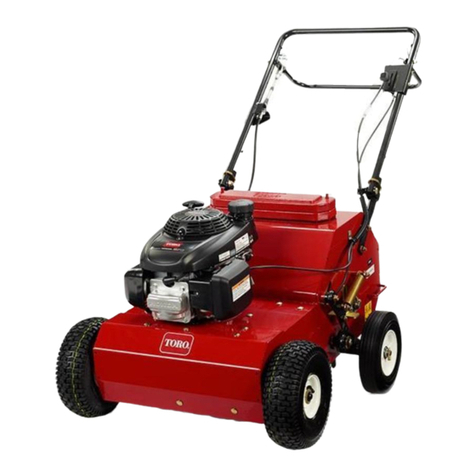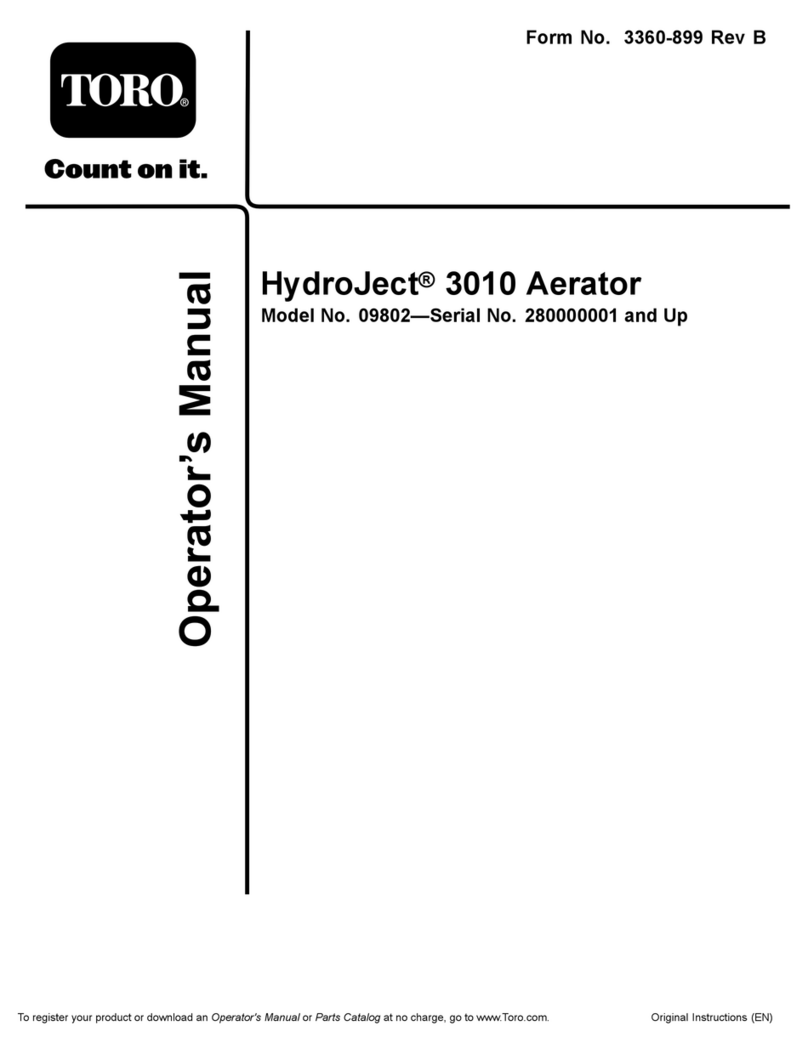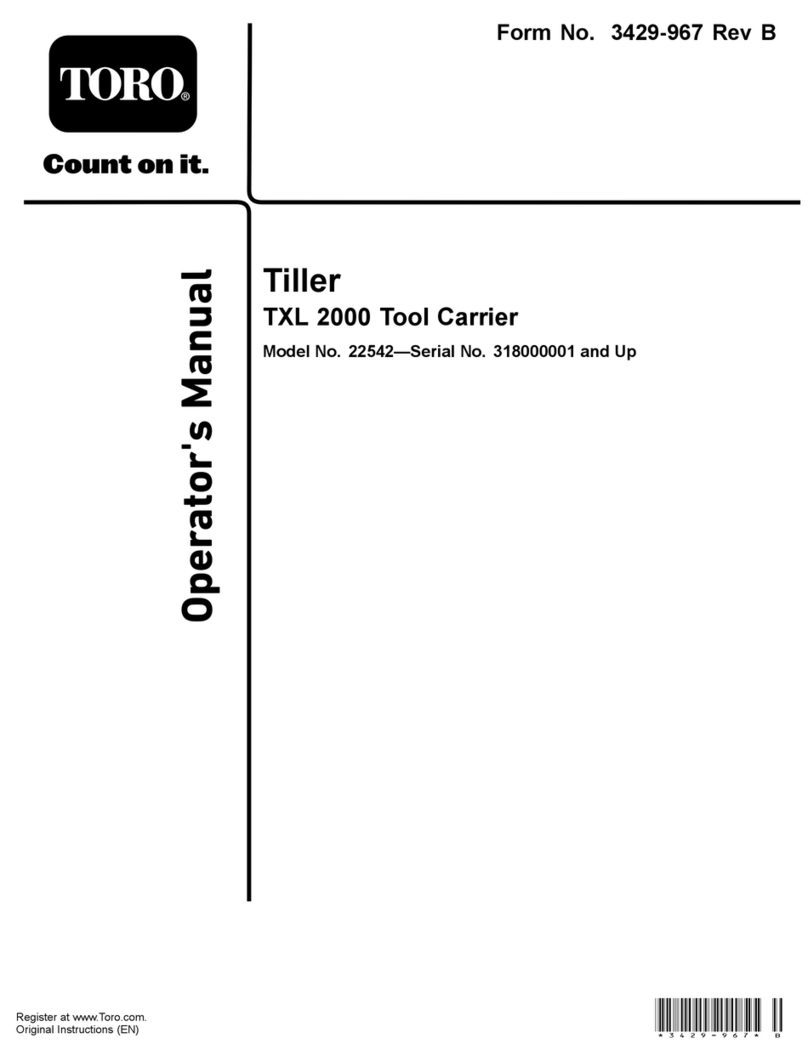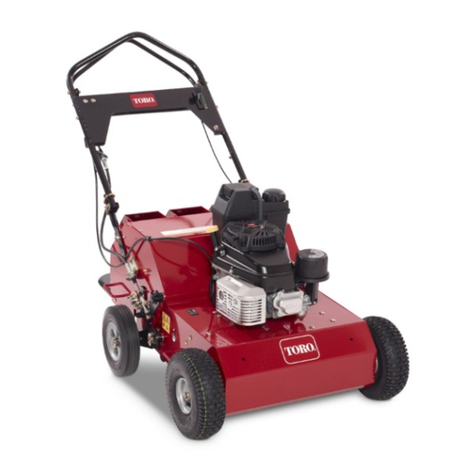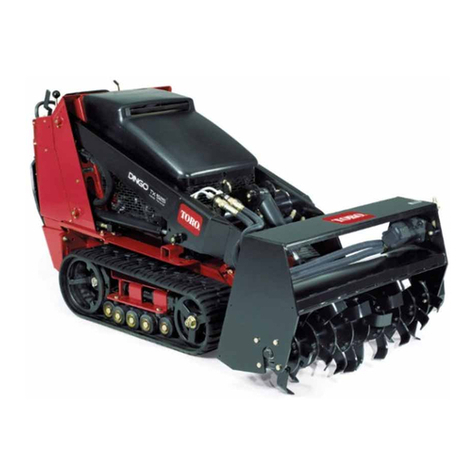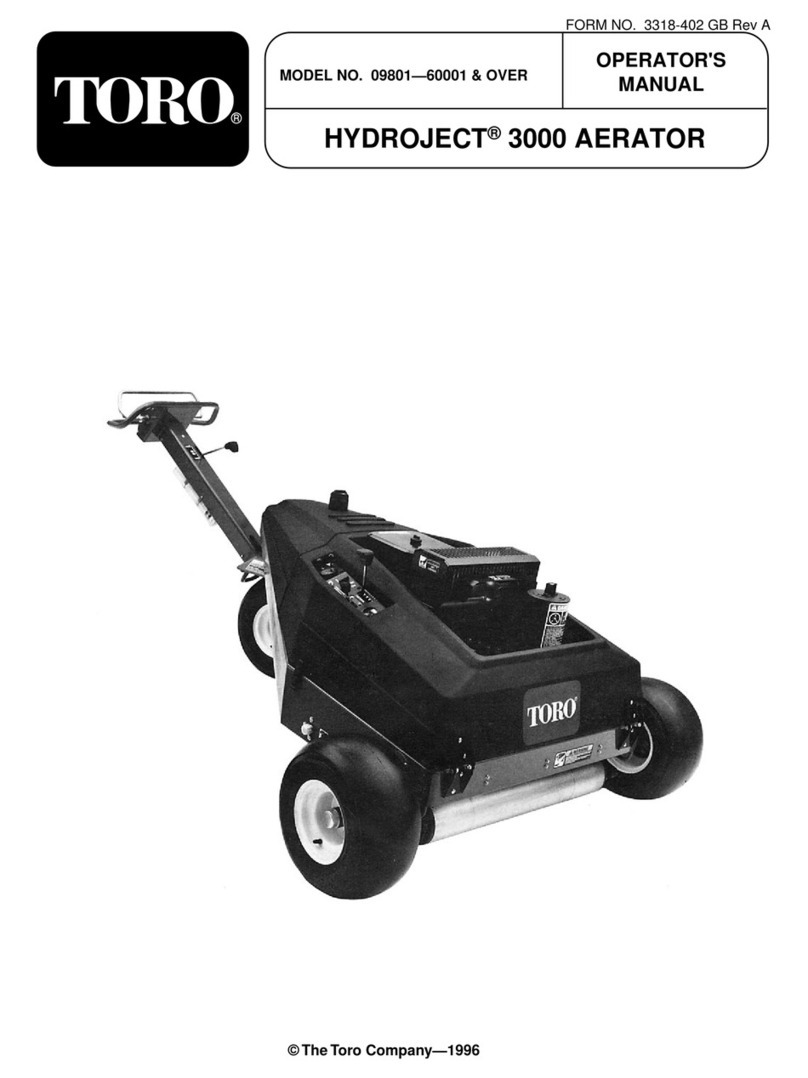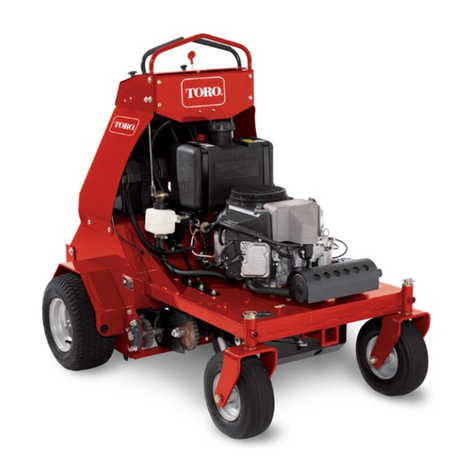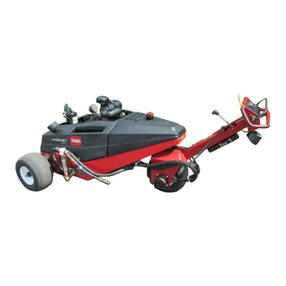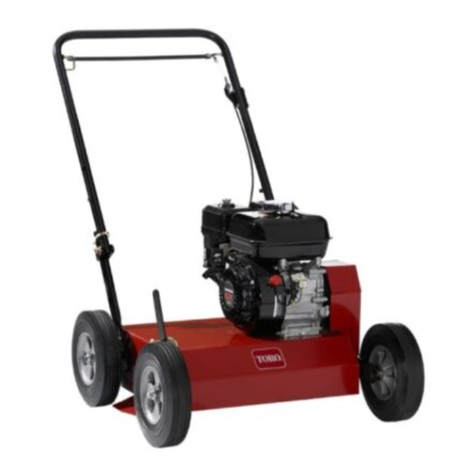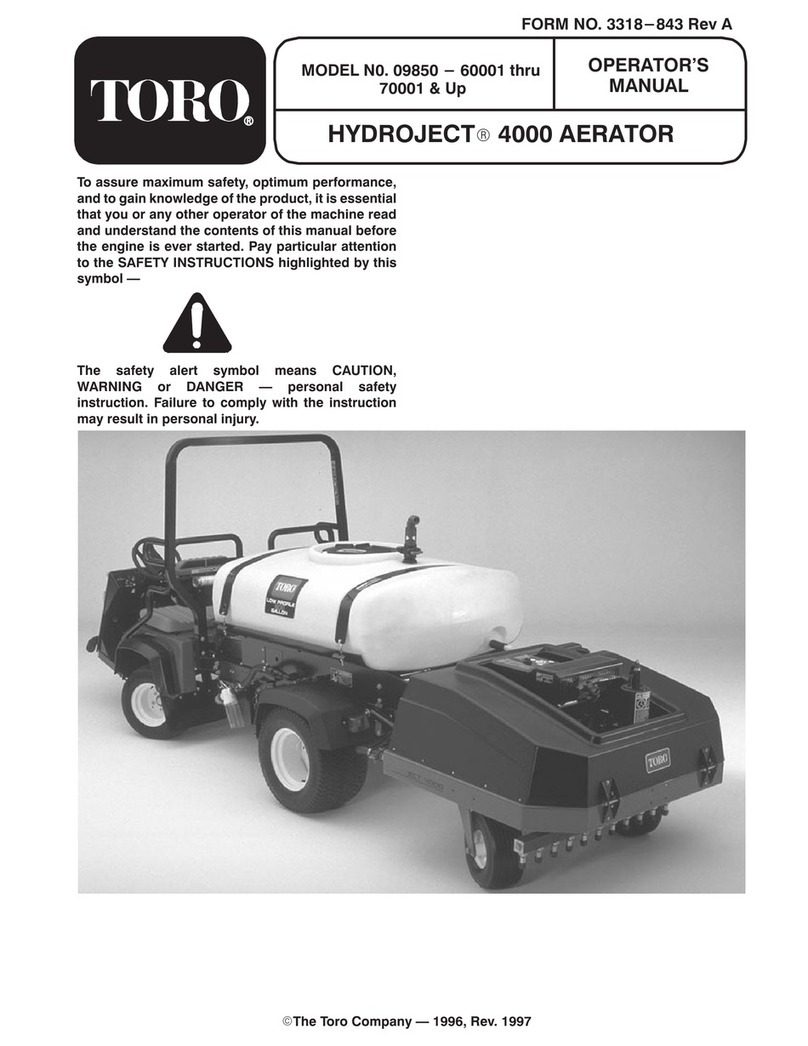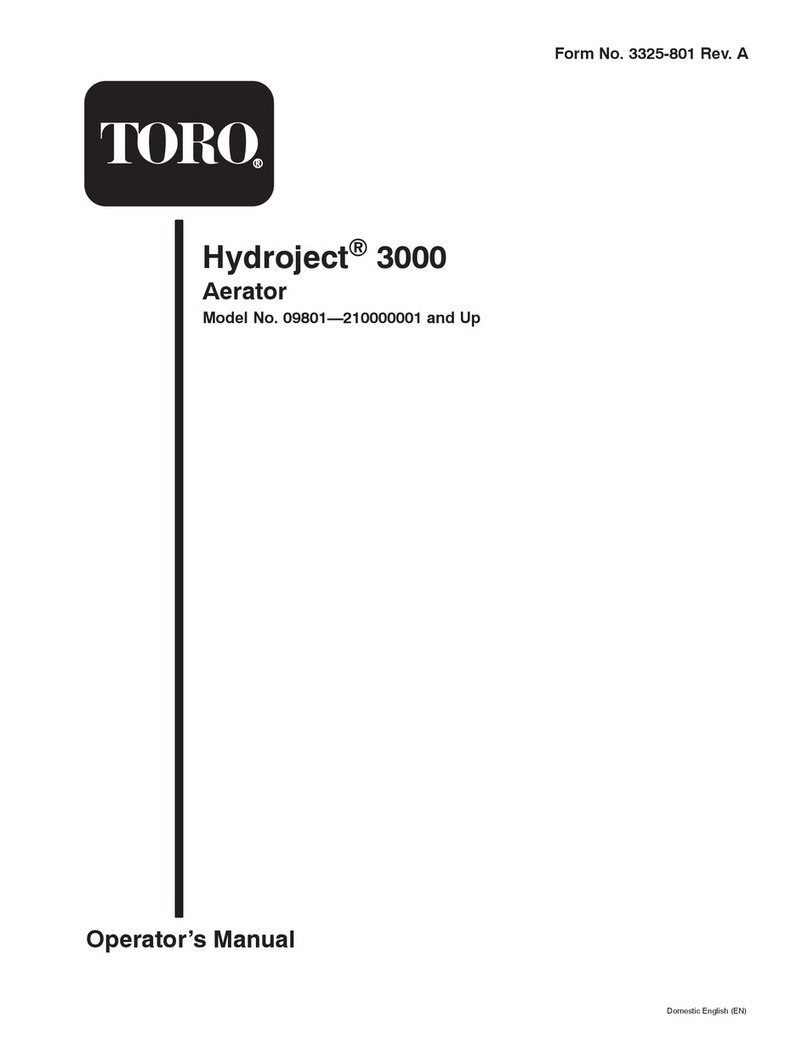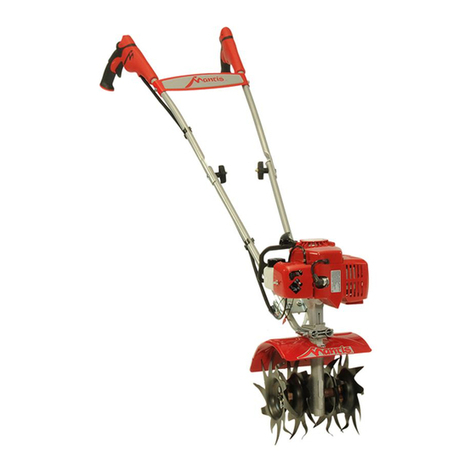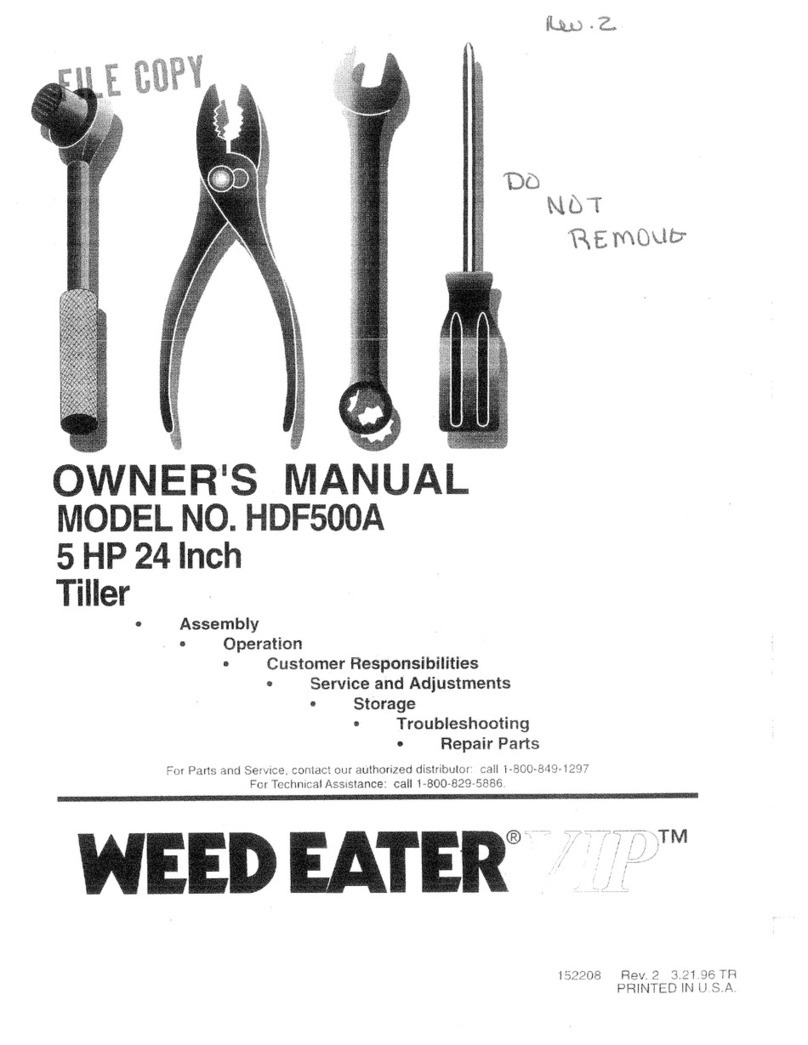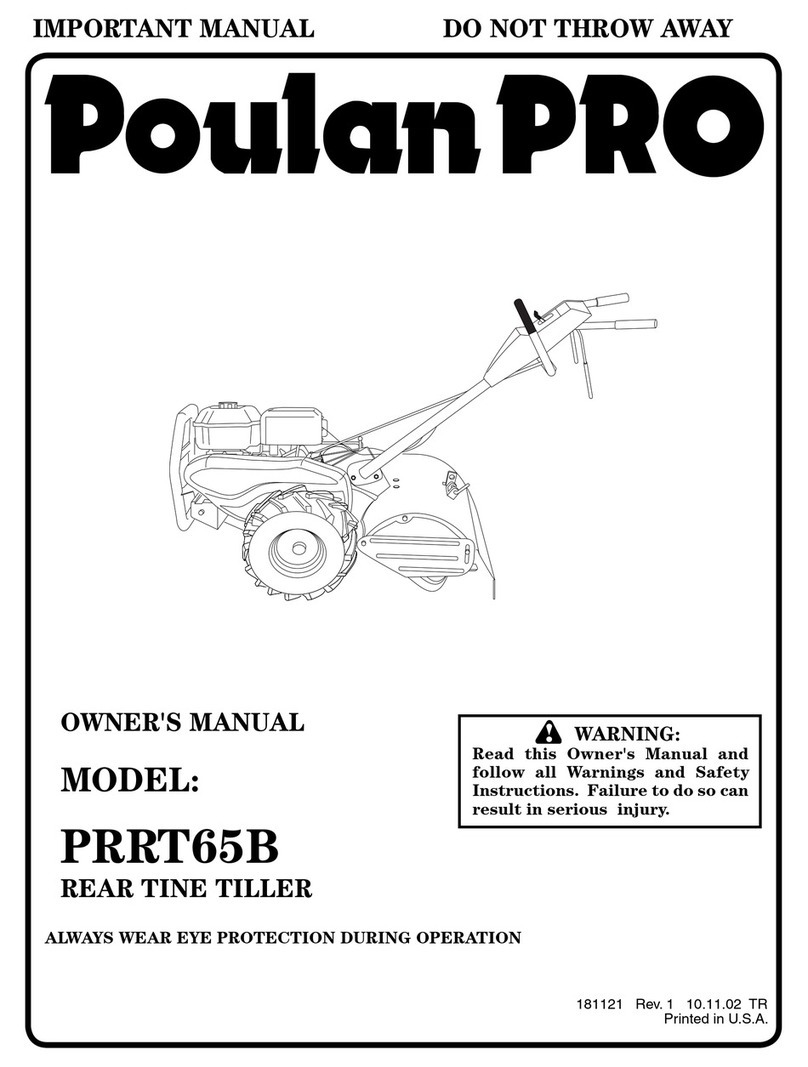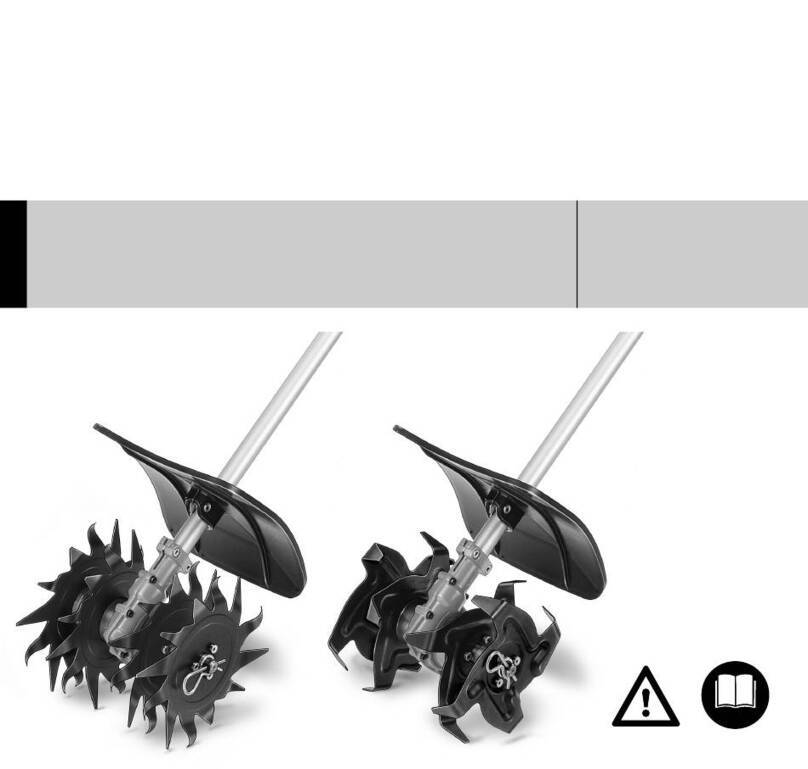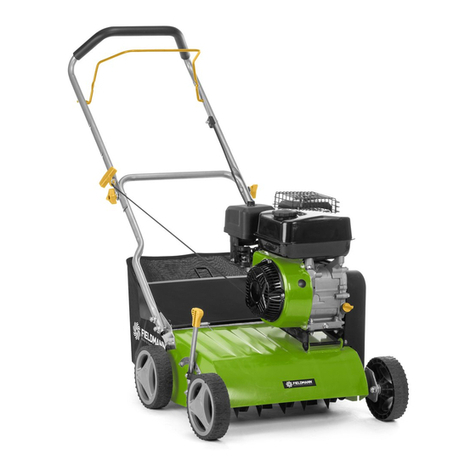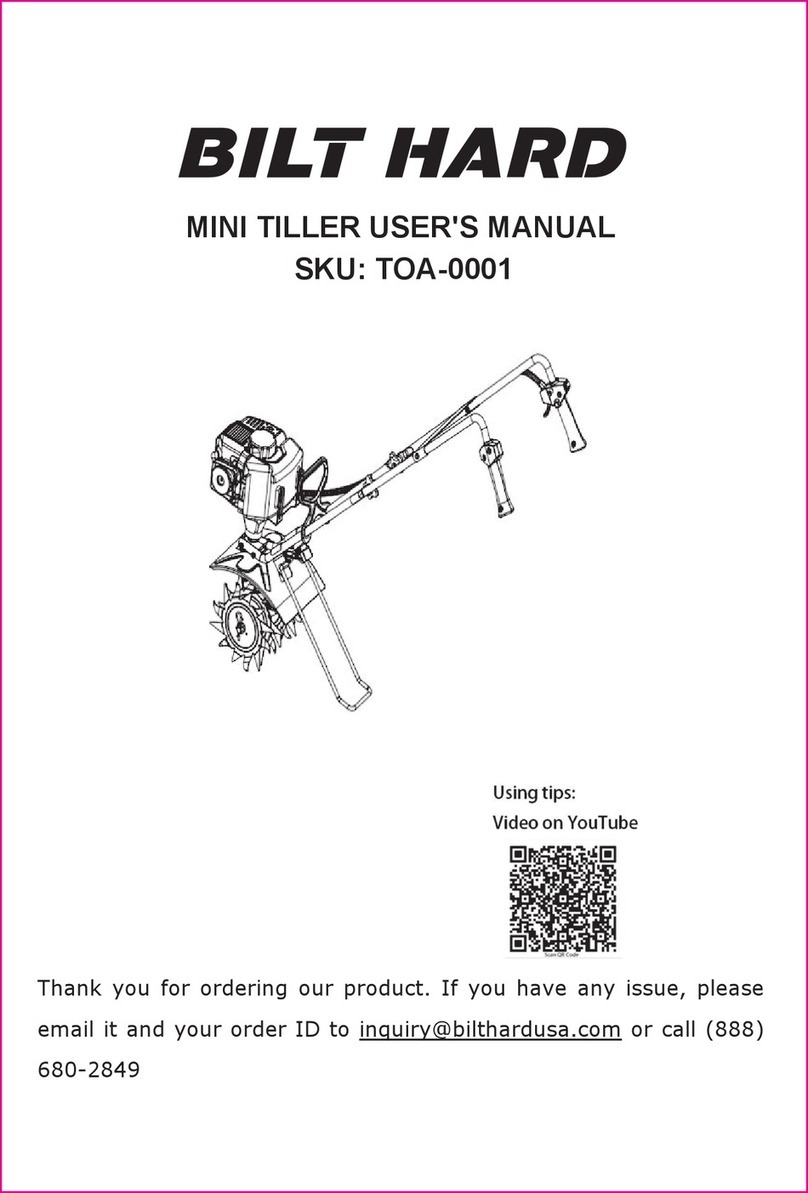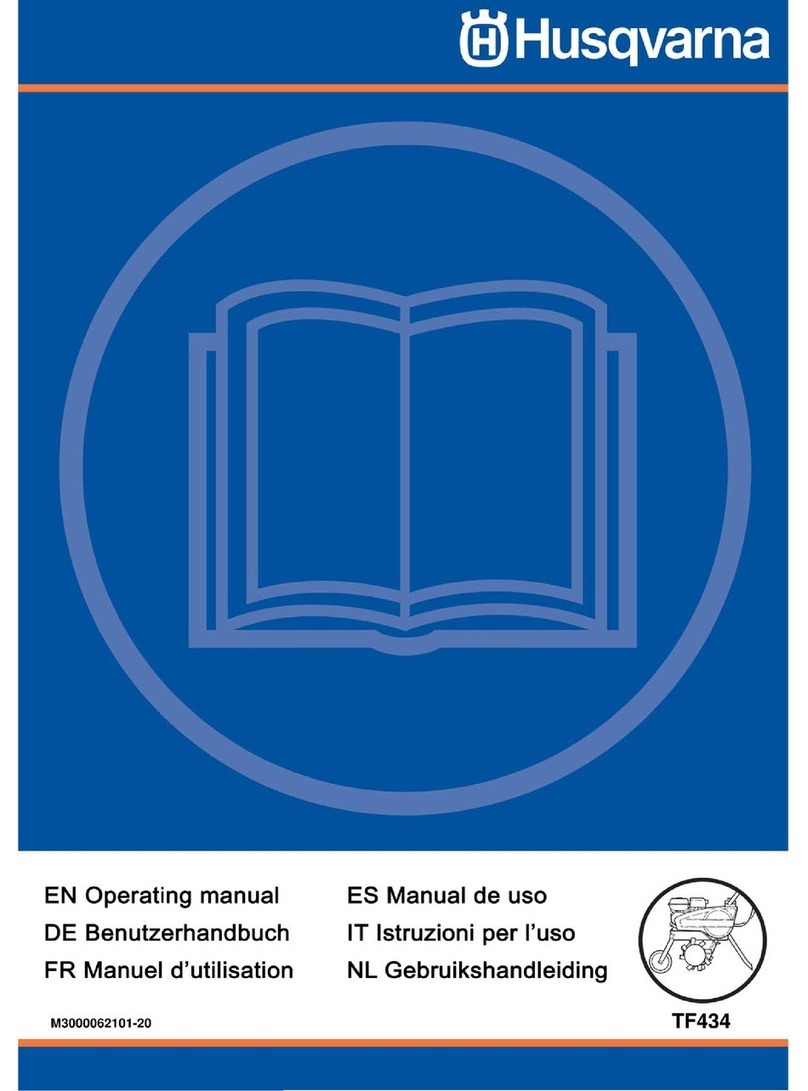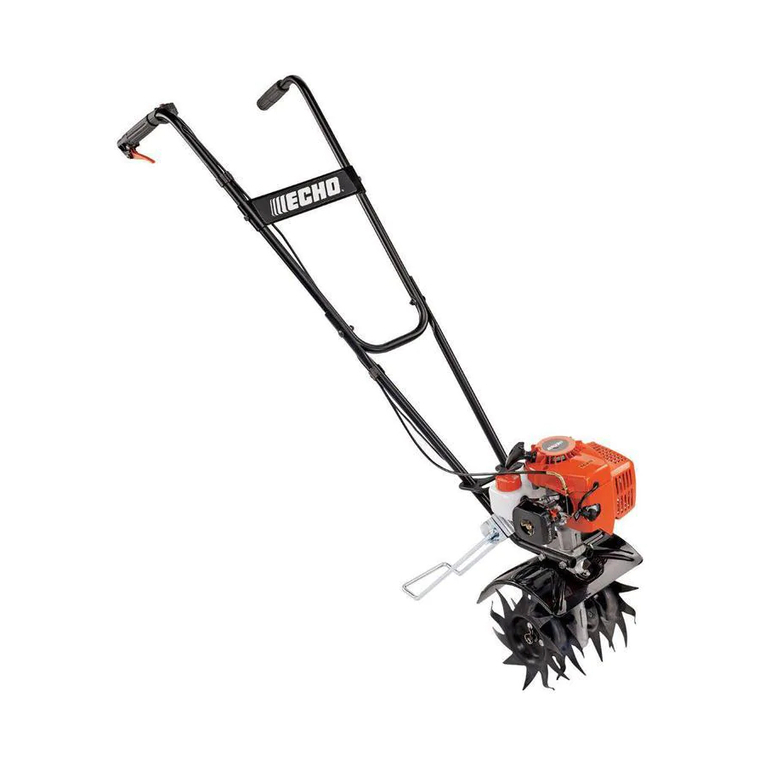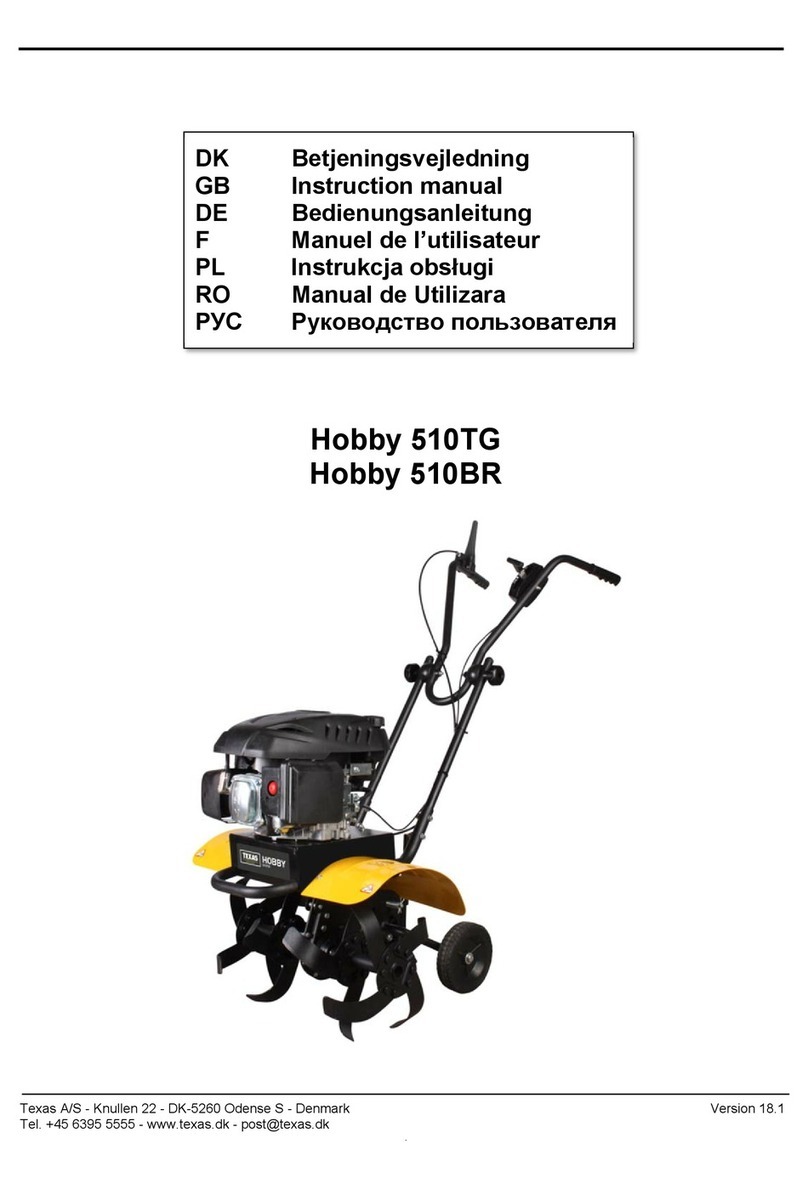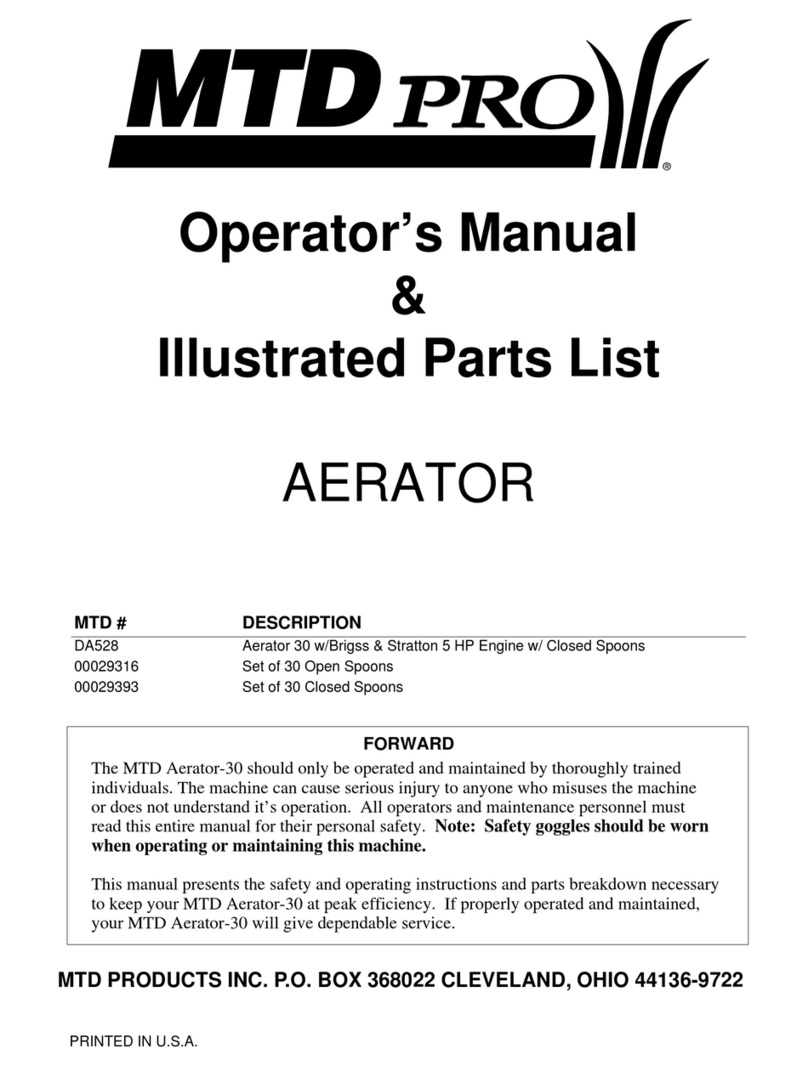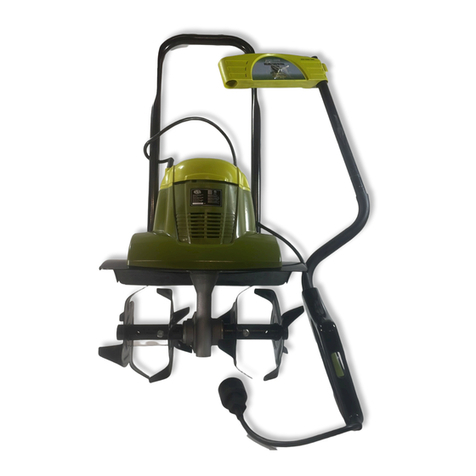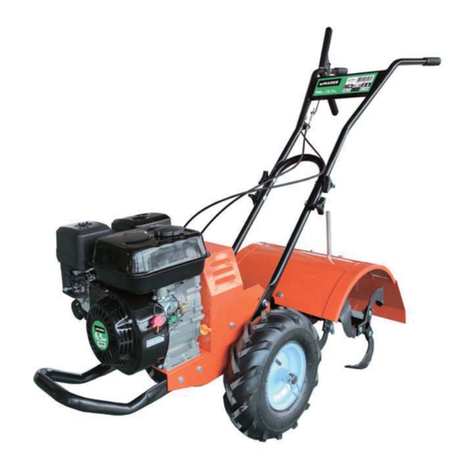Toro Dingo 22445 User manual

Operator’s Manual
English (CE)
Form No. 3324-220 Rev A
Tiller
DingoAttachment
Model No. 22445—200000001 & Up

The Toro Company – 1999
8111 Lyndale Ave. South
Bloomington, MN 55420–1196 All Rights Reserved
2
Printed in the USA
Contents
Page
Introduction 2. . . . . . . . . . . . . . . . . . . . . . . . . . . . . . . .
Safety 2. . . . . . . . . . . . . . . . . . . . . . . . . . . . . . . . . . . . .
Safety Decals 3. . . . . . . . . . . . . . . . . . . . . . . . . . . .
Specifications 3. . . . . . . . . . . . . . . . . . . . . . . . . . . . . . .
Stability Ratings 4. . . . . . . . . . . . . . . . . . . . . . . . . .
Operation 4. . . . . . . . . . . . . . . . . . . . . . . . . . . . . . . . . .
Tips for Tilling 4. . . . . . . . . . . . . . . . . . . . . . . . . . .
Maintenance 5. . . . . . . . . . . . . . . . . . . . . . . . . . . . . . . .
Service Interval Chart 5. . . . . . . . . . . . . . . . . . . . .
Greasing and Lubrication 5. . . . . . . . . . . . . . . . . . .
Adjusting Tiller Drive Chain Tension 5. . . . . . . . .
Tiller Tine Replacement 6. . . . . . . . . . . . . . . . . . .
Storage 6. . . . . . . . . . . . . . . . . . . . . . . . . . . . . . . . .
Troubleshooting 7. . . . . . . . . . . . . . . . . . . . . . . . . . . . .
Introduction
We want you to be completely satisfied with your new
product, so feel free to contact your local Authorized
Service Dealer for help with service, genuine replacement
parts, or other information you may require.
Whenever you contact your Authorized Service Dealer or
the factory, always know the model and serial numbers of
your product. These numbers will help the Service Dealer
or Service Representative provide exact information about
your specific product. You will find the model and serial
number on a plate located on the product.
For your convenience, write the product model and serial
numbers in the space below.
Model No:
Serial No.
The warning system in this manual identifies potential
hazards and has special safety messages that help you and
others avoid personal injury, even death. DANGER,
WARNING and CAUTION are signal words used to
identify the level of hazard. However, regardless of the
hazard, be extremely careful.
DANGER signals an extreme hazard that will cause
serious injury or death if the recommended precautions
are not followed.
WARNING signals a hazard that may cause serious injury
or death if the recommended precautions are not followed.
CAUTION signals a hazard that may cause minor or
moderate injury if the recommended precautions are not
followed.
Two other words are also used to highlight information.
“Important” calls attention to special mechanical
information and “Note” emphasizes general information
worthy of special attention.
The left and right side of the machine is determined by
standing in the normal operator’s position.
Safety
Improper use or maintenance by the operator or owner can
result in injury. To reduce the potential for injury, comply
with these safety instructions and those in the traction unit
operator’s manual. Always pay attention to the safety alert
symbol, which means CAUTION, WARNING, or
DANGER—“personal safety instruction.” Failure to
comply with the instruction may result in personal injury
or death.
DANGER
POTENTIAL HAZARD
•Contact with rotating tines may cause injury.
WHAT CAN HAPPEN
•Rotating tines can cut hands, feet or other body
parts.
HOW TO AVOID THE HAZARD
•Keep away from the rotating tines while
operating the tiller.
•Keep your hands, feet, and any other part of
your body or clothing away from rotating
parts.
•Before adjusting, cleaning, repairing and
inspecting the tiller, lower the tiller and loader
arms to the ground and stop the engine.
Remove the key.

3
WARNING
POTENTIAL HAZARD
•There may be buried power, gas, and/or
telephone lines in the area needing tilling.
WHAT CAN HAPPEN
•Shock or explosion may occur.
HOW TO AVOID THE HAZARD
•Have the property or area to be tilled marked
for buried lines.
WARNING
POTENTIAL HAZARD
•Tines can throw dirt, debris, and small rocks.
WHAT CAN HAPPEN
•The operator or bystander could be injured by
flying debris.
HOW TO AVOID THE HAZARD
•Run the tiller so that debris is thrown away
from the traction unit.
•Keep all bystanders away from the work area.
WARNING
POTENTIAL HAZARD
•When the engine is off, attachments in the
raised position can gradually lower.
WHAT CAN HAPPEN
•Someone nearby may be pinned or injured by
the attachment as it lowers.
HOW TO AVOID THE HAZARD
•Always lower the loader arms before you shut
off the traction unit.
Safety Decals
# 93–7321
2
1
3
# 100–4708
4
5
Figure 1
1. Cuttinghazard–foot
2. Cutting hazard–hand
3. Keep away from moving
parts
4. Trown object hazard
5. Keep bystanders away
Specifications
Overall width 44.0
in. (112 cm)
Overall length 20.0 in. (51 cm)
Overall height 26.0 in. (66 cm)
Tilling width 40.0
in. (102 cm)
Tine diameter 19.0 in. (48 cm)
Tine speed (max) 245 rpm @ 3600 engine rpm (flow divider @ 9 o’clock position)
Tine speed (recommended) 225 rpm @ 3600 engine rpm (flow divider @ 10 o’clock position)
Tine thickness .25 in. (0.63 cm)

4
Tine width 2.5 in. (6.4 cm)
Number of tines 36
Shaft diameter 1.50 in. (3.8 cm)
Drive Chain ANSI 60 reduction ratio 1.8:1
Hydraulic motor displacement 6.20 cu. in. (102 cc)
Weight 363 lb. (165 kg)
Stability Ratings
To determine the degree of slope you can traverse with the
tiller installed on a traction unit, find the stability rating
for the hill position you want to travel in the table below,
then find the degree of slope for the same rating and hill
position in the Stability Data section of the traction unit
operator’s manual.
Orientation Stability Rating
Front Uphill C
Rear Uphill C
Side Uphill B
Note: The tiller is rated for use without the counterweight.
If you use the counterweight with the tiller, the traction
unit will be less stable in the front and side uphill
positions.
WARNING
POTENTIAL HAZARD
•Exceeding the maximum slope can cause the
traction unit to tip.
WHAT CAN HAPPEN
•If the traction unit tips, you or bystanders could
be crushed.
HOW TO AVOID THE HAZARD
•Do not drive the the traction unit on a slope
steeper that the maximum slope.
Operation
IMPORTANT: Lift and move the attachment using the
traction unit.
Refer to your traction unit Operator’s Manual for more
information on installing and removing the tiller from
your traction unit.
Tips for Tilling
•Clean the area of trash, branches, and rocks before
tilling to prevent equipment damage.
•Always begin tilling with the slowest ground speed
possible. Increase speed if conditions permit.
•Always use full throttle (maximum engine speed).
•Till in long, straight passes. Do not make turns while
the tiller is in the ground, as equipment damage may
result.
•Avoid excessive tilling of the soil, as finely tilled soil
will not absorb moisture easily and puddles of water or
run-off may occur.
•When tilling hard packed, very dry, or virgin soil, raise
the tiller so only the very top of the soil is penetrated.
On succeeding passes the depth may be lowered.
•Run the tiller so that the dirt is thrown away from you.
•If a rock or other obstruction gets into the tiller tines,
reverse the rotation direction to dislodge it.

5
Maintenance
Service Interval Chart
Service Operation Each
Use 5
Hours 25
Hours Storage
Service Notes
Shaft bearing–lubricate X X
Chain tension–adjust and lubricate initial X
Tines–check X Replace as required
Tine bolts–check and tighten XReplace as required
Chipped surfaces–paint X
CAUTION
POTENTIAL HAZARD
•If you leave the key in the ignition switch, someone could start the engine.
WHAT CAN HAPPEN
•Accidental starting of the engine could seriously injure you or other bystanders.
HOW TO AVOID THE HAZARD
•Remove the key from the ignition switch before you do any maintenance.
Greasing and Lubrication
Service Interval/Specification
Grease the 2 tiller shaft fittings every 25 operating hours.
Grease immediately after every washing.
Grease Type: General-purpose grease.
How to Grease
1. Lower the loader arms and stop the engine. Remove
the key.
2. Clean the grease fittings with a rag.
3. Scrape any paint off the front of the fittings.
4. Connect a grease gun to each fitting.
5. Pump grease into the fittings until grease begins to
ooze out of the bearings.
6. Wipe up any excess grease.
Lubricating Tiller Drive Chain
Lubricate tiller drive chain after the initial 5 hours of
operation and every 25 operating hours thereafter.
Lubricant Type: Commercial chain lube.
1. Lower the loader arms and stop the engine. Remove
the key.
2. Remove the chain drive cover (Fig, 2).
3. Apply a commercial chain lube onto the chain spans.
4. Install the chain drive cover.
Adjusting Tiller Drive Chain
Tension
Adjust the tiller drive chain after the initial 5 hours of
operation and every 25 operating hours thereafter. There
should be 1/2 to 3/4 in. (1 to 2 cm) slack in the chain,
measured mid-way between the sprockets.
1. Lower the loader arms and stop the engine. Remove
the key.
2. Remove the chain drive cover (Fig, 2).
3. Loosen the 2 hydraulic motor, mount plate bolts
(Fig, 2).
4. Using the adjuster bolt, move the hydraulic motor
upward to tighten the chain (Fig, 2).

6
m–4372
2
1
23
Figure 2
1. Chain drive cover
2. Hydraulic motor, mount
plate bolt
3. Adjuster bolt
5. After proper chain tension is attained, tighten the
adjuster bolt and hydraulic motor mount plate bolts
(Fig, 2).
Note: When proper adjustment can no longer be attained
from the adjuster bolt or repeated chain failures occur,
replace chain.
6. Install the chain drive cover.
Tiller Tine Replacement
Check and replace tines when they become worn or dull.
Worn or dull tines will degrade the performance of the
tiller.
Tines should be installed as illustrated in Figure 3 with 2
left hand tines and 2 right hand tines on each hub.
m–4414
2
1
2
1
Figure 3
1. Left hand tine 2. Right hand tine
The cutting edges of the tines should face toward the rear
of the tiller.
Torque the tine mounting bolts to 63 to 77 ft.-lb. (85 to
104 N⋅m).
Storage
1. Before long term storage wash the tiller with mild
detergent and water to remove dirt and grime.
2. Check the condition of the drive chain. Adjust and
lubricate the chain.
3. Grease all fittings.
4. Check and tighten all bolts, nuts, and screws. Repair or
replace any part or tines that are damaged or worn.
5. Paint all scratched or bare metal surfaces. Paint is
available from your Authorized Service Dealer.
6. Store the tiller in a clean, dry garage or storage area.
Cover the tiller to protect it and keep it clean.

7
Troubleshooting
PROBLEM POSSIBLE CAUSES CORRECTIVE ACTION
Tiller does not operate. 1. Hydraulic coupler not
completely connected 1. Check and tighten all couplers.
2. Defective hydraulic coupler 2. Check couplers and replace
any that are defective.
3. An obstruction in a hydraulic
hose 3. Find and remove the
obstruction.
4. Auxiliary valve on the traction
unit is not opening. 4. Repair the valve.
5. An obstruction in the tiller
(e.g., rock or root) 5. Find and remove the
obstruction.
6. Broken drive chain 6. Repair or replace the chain.
7. Loose drive chain 7. Adjust the chain tension.
8. Defective hydraulic valve 8. Replace or repair the defective
valve.
9. Defective drive motor 9. Replace or repair the drive
motor.

Table of contents
Other Toro Tiller manuals
